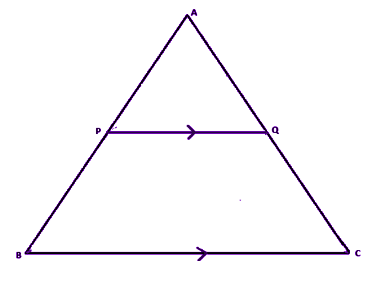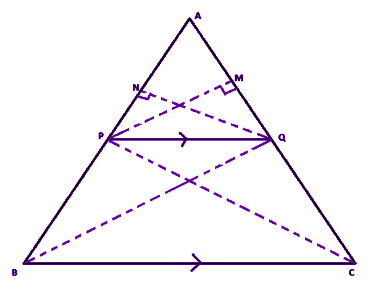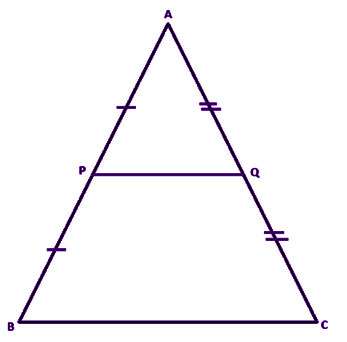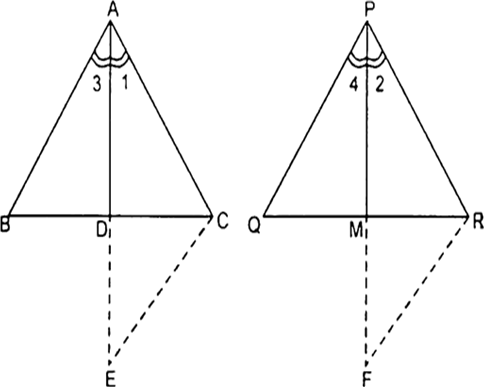Ask questions which are clear, concise and easy to understand.
Ask QuestionPosted by Sonam Kumari Paswan 5 years, 1 month ago
- 0 answers
Posted by Sonam Kumari Paswan 5 years, 1 month ago
- 1 answers
Gaurav Seth 5 years ago
Let 3+√2 is an rational number.. such that
3+√2 = a/b ,where a and b are integers and b is not equal to zero ..
therefore,
3 + √2 = a/b
√2 = a/b -3
√2 = (3b-a) /b
therefore, √2 = (3b - a)/b is rational as a, b and 3 are integers..
It means that √2 is rational....
But this contradicts the fact that √2 is irrational..
So, it concludes that 3+√2 is irrational..
hence proved.
Posted by Sonam Kumari Paswan 5 years, 1 month ago
- 3 answers
Sonam Kumari Paswan 5 years, 1 month ago
Posted by Sudhansh Kumar 5 years, 1 month ago
- 1 answers
Gaurav Seth 5 years, 1 month ago
If a line is drawn parallel to one side of a triangle intersecting the other two sides in distinct points, then the other two sides are divided in the same ratio.
<a id="proof" name="Proof"></a>
Basic Proportionality Theorem Proof
Let us now try to prove the basic proportionality theorem statement
Consider a triangle ΔABC, as shown in the given figure. In this triangle, we draw a line PQ parallel to the side BC of ΔABC and intersecting the sides AB and AC in P and Q, respectively.

According to the basic proportionality theorem as stated above, we need to prove:
AP/PB = AQ/QC
Construction
Join the vertex B of ΔABC to Q and the vertex C to P to form the lines BQ and CP and then drop a perpendicular QN to the side AB and also draw PM⊥AC as shown in the given figure.

Proof
Now the area of ∆APQ = 1/2 × AP × QN (Since, area of a triangle= 1/2× Base × Height)
Similarly, area of ∆PBQ= 1/2 × PB × QN
area of ∆APQ = 1/2 × AQ × PM
Also,area of ∆QCP = 1/2 × QC × PM ………… (1)
Now, if we find the ratio of the area of triangles ∆APQand ∆PBQ, we have
area of ΔAPQarea of ΔPBQ = 12 × AP × QN12 × PB × QN = APPB
Similarly, area of ΔAPQarea of ΔQCP = 12 × AQ × PM12 × QC × PM = AQQC ………..(2)
According to the property of triangles, the triangles drawn between the same parallel lines and on the same base have equal areas.
Therefore, we can say that ∆PBQ and QCP have the same area.
area of ∆PBQ = area of ∆QCP …………..(3)
Therefore, from the equations (1), (2) and (3) we can say that,
AP/PB = AQ/QC
Also, ∆ABC and ∆APQ fulfil the conditions for similar triangles, as stated above. Thus, we can say that ∆ABC ~∆APQ.
The MidPoint theorem is a special case of the basic proportionality theorem.
According to mid-point theorem, a line drawn joining the midpoints of the two sides of a triangle is parallel to the third side.
Consider an ∆ABC.

Conclusion
We arrive at the following conclusions from the above theorem:
If P and Q are the mid-points of AB and AC, then PQ || BC. We can state this mathematically as follows:
If P and Q are points on AB and AC such that AP = PB = 1/2 (AB) and AQ = QC = 1/2 (AC), then PQ || BC.
Also, the converse of mid-point theorem is also true which states that the line drawn through the mid-point of a side of a triangle which is parallel to another side, bisects the third side of the triangle.
Hence, the basic proportionality theorem is proved.
Posted by Khushi Kumari 5 years, 1 month ago
- 1 answers
Gaurav Seth 5 years ago
Given: Triangle ABC and ∆PQR in which AD and PM are medians drawn on sides BC and QR respectively. It is given that

To Prove : ∆ABC ~ ∆PQR
Const : Produce AD to E such that AD = DE and PM to F such that PM = MF.

Proof : In ∆ABD and ∆CDE,
AD = DE [by construction]
∠ADB = ∠CDE
[vertically opposite angles]
and BD = DC [AD is a median]
Therefore, by using SAS congruent condition


 [by CPCT]
[by CPCT]
Similarly, we can prove


 [by CPCT]
[by CPCT]
It is given that:






Therefore, by using SSS congruent condition


 ...(i)
...(i)
Similarly,  ...(ii)
...(ii)
Adding (i) and (ii), we get
∠1 + ∠3 = ∠2 + ∠4
∠A = ∠P
Now, in ∆ABC and ∆PQR

and 
Therefore, by using SAS similar condition
∆ABC ~ ∆PQR Hence Proved.
Posted by Kushal Hs 5 years, 1 month ago
- 1 answers
Posted by Shiv Kumar 5 years, 1 month ago
- 1 answers
Posted by Mukul Kumar 5 years, 1 month ago
- 1 answers
Posted by Byna Chandra Kiran 5 years, 1 month ago
- 2 answers
Gaurav Seth 5 years, 1 month ago
16th term in given A.P is 78
Step-by-step explanation:
Given A.P : 3,8,13,18,....,78
First term (a) = 3 ,
common difference (d)=
= $8-3$
= $5$
Therefore,
16th term in given A.P is 78
Posted by Annu Thegitl 5 years, 1 month ago
- 0 answers
Posted by Aayushi Waske 5 years, 1 month ago
- 3 answers
Daniya Khan 5 years, 1 month ago
Daniya Khan 5 years, 1 month ago
Gaurav Seth 5 years, 1 month ago
Answer:
The coordinates of point P are
Step-by-step explanation:
The line segment joining the points A(3,4) and B(7,9).
Let point P divides the line segment AB internally in he ratio 2:3.
The section formula is
Using the section formula, we get
Posted by Hemu Cherry 5 years, 1 month ago
- 3 answers
Posted by Saranam Naga Dhathri 5 years, 1 month ago
- 5 answers
Daniya Khan 5 years, 1 month ago
Posted by Shagun Sharma 5 years, 1 month ago
- 2 answers
Yogita Ingle 5 years, 1 month ago
When we toss two coins simultaneously then the possible of outcomes are: (two heads) or (one head and one tail) or (two tails) i.e., in short (H, H) or (H, T) or (T, T) respectively; where H is denoted for head and T is denoted for tail.
Posted by Shagun Sharma 5 years, 1 month ago
- 1 answers
Posted by Shagun Sharma 5 years, 1 month ago
- 2 answers
Daniya Khan 5 years, 1 month ago
Yogita Ingle 5 years, 1 month ago
Edge of the cube = diameter of sphere = 7 cm
Radius of the sphere = = 3.5 cm
Volume of the sphere =
= 179.67
Posted by Shagun Sharma 5 years, 1 month ago
- 0 answers
Posted by Leesarani Pradhan 5 years, 1 month ago
- 1 answers
Yogita Ingle 5 years, 1 month ago
We know that circumference of a circle = 2π r.
We know that diameter = 2r.
Given circumference of a circle exceeds diameter by 16.8cm.
2πr - 2r = 16.8
2r(π - 1) = 16.8
2r(22/7 - 1) = 16.8
2r(22 - 7/7) = 16.8
2r(15/7) = 16.8
30r = 16.8 * 7
30r = 117.6
r = 117.6/30
r = 3.92 cm.
Therefore the radius of the circle = 3.92cm.
Posted by Disha Wadhwani 5 years, 1 month ago
- 5 answers
Posted by Manan Vijay 5 years, 1 month ago
- 1 answers
Gaurav Seth 5 years ago
- Don't post personal information, mobile numbers and other details.
- Don't use this platform for chatting, social networking and making friends. This platform is meant only for asking subject specific and study related questions.
- Be nice and polite and avoid rude and abusive language. Avoid inappropriate language and attention, vulgar terms and anything sexually suggestive. Avoid harassment and bullying.
- Ask specific question which are clear and concise.
If content is found in violation, the user posting this content will be banned for 30 days from using Homework help section. Suspended users will receive error while adding question or answer. Question comments have also been disabled. Read community guidelines at https://mycbseguide.com/community-guidelines.html
Posted by Shin Chan 5 years, 1 month ago
- 2 answers
Posted by Shin Chan 5 years, 1 month ago
- 0 answers
Posted by Bm Vinay 5 years, 1 month ago
- 1 answers
Gaurav Seth 5 years, 1 month ago
Let given cubic polynomial be
p(x) = 3x³ - 5x² - 11x - 3
i ) If x = 3 , then
p(3) = 3(3)³ - 5(3)² - 11(3) - 3
= 81 - 45 - 33 - 3
= 81 - 81
= 0
ii ) If x = -1 , then
p(-1) = 3(-1)³ - 5(-1)² - 11(-1) - 3
= -3 - 5 + 11 - 3
= -11 + 11
= 0
iii ) If x = -1/3 , then
p(-1/3) = 3(-1/3)³ - 5(-1/3)² - 11(-1/3) - 3
= -3/27 - 5/9 + 11/3 - 3
= -1/9 - 5/9 + 11/3 - 3
= ( -1 - 5 + 33 - 27 )/9
= ( -33 + 33 )/9
= 0
Therefore ,
p(3) = p(-1) = p(-1/3) = 0 .
So, 3 , -1 , -1/3 are zeroes of given
cubic polynomial 3x³ - 5x² - 11x - 3 .
Compare the coefficients of given
cubic polynomial 3x³ - 5x² - 11x - 3
with ax³ + bx² + cx + d , we get
a = 3 , b = -5 , c = -11 , d = -3
Let the zeroes of the given cubic
polynomial p(x) are p =3 , q=-1, r=-1/3
Now ,
p+q+r = 3 - 1 - 1/3
= 2 - 1/3
= ( 6 - 1 )/3
= 5/3
= -b/a
pq+qr+rp
= 3(-1)+(-1)(-1/3)+(-1/3)(3)
= -3 + 1/3 - 1
= -4 + 1/3
= ( -12 + 1 )/3
= -11/3
= c/a
pqr = 3 × ( -1 ) × ( -1/3 )
= 1
=- d/a
Posted by Anushka ................. 5 years, 1 month ago
- 1 answers
Posted by Anjali Mishra 5 years, 1 month ago
- 1 answers
Gaurav Seth 5 years ago
Let r cm be the radius of the hemisphere, then r = 1 cm.
Let R be the radius of the cone and h cm be the height. Then

R = 1 cm and h = 1 cm
[It is given that R = h)
Now, Volume of solid
= Volume of hemisphere + volume of cone

Posted by Nandini Kolli 5 years, 1 month ago
- 1 answers
Gaurav Seth 5 years ago
class freq total
0-6 10 3 * 10
6-12 p 9 * p
12-18 4 4 * 15
18-24 7 7 * 21
24-30 q 27 * q
30-36 4 4 * 33
36-42 1 1 * 39
=====================
total 40 408 + 9p + 27 q
============================
total of frequencies = 26 + p + q = 40 => p+q = 14
sum = 408 + 9 p + 27 q = 14.7 * 40 = 588
So finally, 9 p + 27 q = 180 => p + 3 q = 20
=> 14- q + 3 q = 20 => q = 3 and p = 11 .

myCBSEguide
Trusted by 1 Crore+ Students

Test Generator
Create papers online. It's FREE.

CUET Mock Tests
75,000+ questions to practice only on myCBSEguide app
 myCBSEguide
myCBSEguide